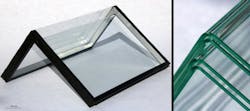Laser-assisted heating forms perfect corners in architectural glass
Conventionally, for office blocks and apartment buildings that require windows that wrap around the corners of the structure, window manufacturers join two panes of glass at an angle, using either a metal profile or an adhesive bond. Now, however, researchers from the Fraunhofer Institute for Mechanics of Materials IWM (Freiburg, Germany) have developed a way of bending sheets of glass up to angles of 90° so that the corner thereby produced is sharp and angular. In other words, they have made the corner an integral part of a single sheet of glass.
Techniques for bending glass do of course already exist; current technology, however, is incapable of producing very small curvatures or a clean-edged bend of 90°. In addition, conventional processes often impair the optical properties of the glass. To bend a sheet of glass, it is placed in a metal mold and then reheated, which renders the glass soft and malleable so that it can be shaped according to the contours of the mold. This can cause the glass to deform at the contact points with the support. So once the glass has cooled down, faint imprints remain that are visible when inspected at close range. Moreover, the molding process causes corrugations to form on the surface of the glass, with the result that light is no longer reflected uniformly. When passersby look at the curved parts of a building’s glass facade, the reflections of objects such as trees or street signs therefore appear distorted. Similarly, objects viewed from within the building look strangely skewed.
The team from Fraunhofer IWM has circumvented this problem by developing their own kiln. Instead of heating the entire sheet of glass until it becomes soft, only the area of the glass where the actual bending is to take place is heated to that point by a high-power beam guided along the bend line. The kiln is heated to around 500°C, just below the so-called glass transition temperature, at which point glass becomes soft. “And then the laser only has to heat the glass at the relevant area by a few more degrees until it reaches the glass transition temperature, and we are able to bend it,” says Tobias Rist, a specialist in glass forming at Fraunhofer IWM and head of the Glass Forming and Machining group.
In this case, bending is accomplished by means of gravity. In the kiln, the sheet of glass rests on a support that only extends as far as the line of the future bend. Once the laser has heated the glass along this line, the sheet of glass becomes soft and bends purely through the force of gravity. Since only the line of the bend is heated until soft, rather than the entire sheet, there are no imprints created where the sheet rests on the support. In other words, the glass remains perfectly smooth except for where it has been bent.
The process can also be used to bend a series of glass sheets to specific, graduated radii so as to produce sandwich structures and sheets of laminated, safety, and insulating glass.
“We’ve already had lots of positive feedback from architects,” says Rist. “A lot of them are now keen to know when this corner glass will be available. But our lab system only processes sheets of glass one square meter in size, so we’re only able to produce prototypes.” The research team is therefore eager to join forces with partners and scale up the process to produce larger formats.
According to Rist, there are potential applications in other areas apart from architecture, including industrial design. For example, this technique could be used to cover household appliances with a continuous sheath of glass, instead of the usual combination of plastic and metal sheets. This glass skin would extend down from the top to the angled front of the appliance, without gaps or joints, and cover a touchscreen control panel. Such a design would be not only highly attractive but also simple to clean on account of the gap-free surface.
For reasons of hygiene, glass is also an ideal material for the manufacture of medical equipment. Steel, by contrast, is relatively easy to scratch. High heat or strong disinfectants are then required to eradicate the germs that can accumulate in the scored surface. Equipment with a glass surface is much easier to clean, not least because glass is highly resistant to scratching and is able to withstand aggressive cleaning agents.
Rist and his team are interested in working with manufacturers from a wide variety of sectors.
Source: https://www.fraunhofer.de/en/press/research-news/2019/october/how-to-bend-plate-glass-perfectly-around-corners.html
About the Author
John Wallace
Senior Technical Editor (1998-2022)
John Wallace was with Laser Focus World for nearly 25 years, retiring in late June 2022. He obtained a bachelor's degree in mechanical engineering and physics at Rutgers University and a master's in optical engineering at the University of Rochester. Before becoming an editor, John worked as an engineer at RCA, Exxon, Eastman Kodak, and GCA Corporation.

